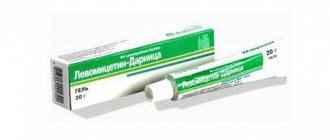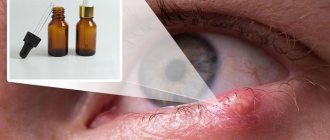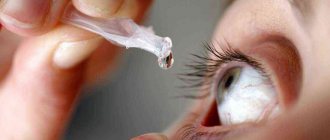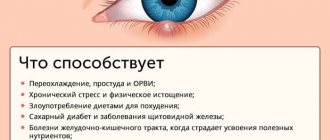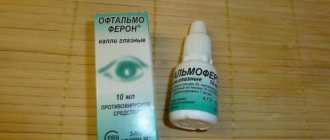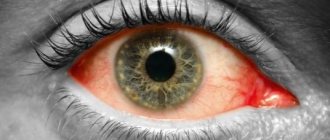Barley primarily affects the hair follicle of the eyelash or (less commonly) the lobules of the meibomian glands of the upper or lower eyelid, which secrete fatty secretions. Barley on the hair follicle of the eyelashes is called external and is more common. Barley on the meibomian glands - internal. It happens less often, but it is also more difficult to treat externally. Which ointment for barley is the most effective?
The appearance of symptoms of the disease
- Severe itching appears in the area of the edge of the eyelid with eyelashes
- The eyelid becomes painful when touched
- Swelling of the eyelid, its redness
- Excessive tearing from the eye
- Feeling like there's a speck in your eye
- Appearance of a yellow purulent vesicle (3-4 days of illness)
- Opening of the abscess ((4-5 days)
Despite the small localization (only the eye area), amateur treatment in the form of squeezing out pus or applying wet hot compresses can end badly for the patient. After all, internal stye is already an abscess occurring in the eyelid and can spread to organs that lie deeper. What is located deeper there? Brain? Congratulations: by performing intensive care or even surgery, without having a medical education, you brought pathogenic flora right there, causing deadly meningitis.
The external gordiolum can behave in exactly the same way if you try to squeeze out the abscess that appears on the 4-5th day on top of the initially itchy red swelling of the eyelid.
The only sure thing that a non-medical person who has contracted this scourge can do is to use special eye ointments containing antibiotics or other strong anti-inflammatory drugs.
Barley factors
Staphylococcus aureus (less commonly, streptococci) is activated, causing inflammation in the hair follicle of the eyelash or in the sebaceous gland of the eyelid under certain external factors. This:
- Gastrointestinal problems due to which vitamins are poorly absorbed into the blood.
- Hypothermia of the body, which will result in colds and a general decrease in the body’s immune properties.
- Poor nutrition, passion for diets, especially vegan ones.
- Stress, excessive (“exhausting”) physical activity (hello from the fitness room with its overly demanding trainer)
- Chronic tonsillitis, untreated caries, adenoids.
- Violation of hygiene rules (wiping eyes with unwashed hands)
- Contact lenses. The lenses themselves, subject to the rules of wearing and caring for them, cannot be the cause of the appearance of stye, but in combination with other circumstances they can provoke its appearance.
Hydrocortisone ointment for barley
The main thing you need to know about this ointment is that, although it is very effective in treating eye inflammation (including barley), it is not an independent drug. Because hydrocortisone is a hormonal antihistamine, and as such it can be indispensable in combination with antibiotics, to which many are allergic. The antihistamine effect of hydrocortisone just stops this deficiency of the antibiotic, preventing its incompatibility with the body.
So, without having an antibacterial effect, hydrocortisone combats symptoms well, which in the case of stye is no less important - just the maddening itching of a diseased eyelid can infuriate a person. And besides itching, the exudative, antihistamine effect of hydrocortisone also has a beneficial effect in that the redness, soreness and swelling of the eyelid are removed.
Apply to the stye area with a cosmetic stick with a thick cotton swab at the end 2-3 times a day. They use it simultaneously with antibacterial drugs until the last signs of barley disappear. Contraindicated for fungal and viral eye diseases.
Drug treatment of barley
Medicines for barley come in a wide variety. Hordeolum is treated with antibiotics in the form of drops, ointments or tablets. Additionally, antiseptics are prescribed.
If the contents of the stye do not come out on their own, the abscess is opened in the hospital and antibacterial drugs are prescribed to treat the infection.
Anyone should know how to treat hordeolum. Most often this is drug therapy using the following drugs:
- Antibiotic drops are considered the most popular. Simple and easy to use, you can carry it in your purse and use it at work. Eye drops destroy pathogenic microorganisms and prevent the development of inflammation.
- Antibacterial ointments are prescribed simultaneously with drops. These include Tetracycline, Floxal, Erythromycin and others.
- Medicines with antibiotics for internal use. Available in tablet form. Prescribed to patients with complicated forms of pathology.
- Antiseptic medications are necessary for washing the eye after opening the abscess.
For barley, medications are prescribed to strengthen the immune system and to eliminate general symptoms of the disease. For example, headache, fever. For severe inflammation, NSAIDs are prescribed.
Ichthyol ointment for stye on the eye
The venerable age of this ointment (it appeared as a remedy in 1883 in Hamburg, Germany!) does not make it less effective than any modern medicines. Just like hydrocortisone, ichthyol ointment is not an independent drug, but it works well in combination with antibiotics.
Its action is specific: after application to the edge of the eyelid near the eyelashes, it first causes mild irritation in the form of a barely noticeable burning or tingling sensation. Which, however, quickly pass and are replaced by a feeling of complete numbness of the eyelid - this is how the anesthetic effect of the drug manifests itself, removing pain and itching from barley.
The drug is perfectly stored without losing its properties, even at room temperature. The main condition for long-term storage is the absence of oxygen access to the ointment, so the tube with it must be carefully closed, squeezing out air from the internal cavity.
The ointment is made on the basis of mineral oil, which is obtained by distilling Alpine oil shale. These shales were formed from fish or waterfowl that died many millions of years ago in an era when the planet was almost completely covered by a primeval ocean. Hence the name – ichthyol, with the root “ichthy” meaning fish. This ointment was created by the German doctor Paul Gerson Unna in alliance with the chemist Rudolf Schröter. Initially it was used to treat eczema, but as it was used in clinical practice, other healing properties of ichthyolka were revealed, including in the treatment of boils and barley.
Apply to the area of inflammation three times a day until the last symptoms of the disease disappear. Available without a prescription in glass pharmaceutical jars or tubes No. 6 and 10. Easily washed off with water.
Drops for a child
Now let's talk about eye drops against stye, which are approved for use by children.
Tobrex
The drug can be used in patients of any age group, including newborns. The active component is tobramycin, an antibiotic from the aminoglycoside group. Streptococci, staphylococci, Klebsiella, diphtheria bacteria, and E. coli are sensitive to the action of the antibacterial component. The only contraindication for use is hypersensitivity to the active ingredient.
Tobrex may cause unpleasant side effects:
- eye irritation;
- redness and swelling of the mucous membrane;
- Pain in the eyes;
- corneal ulcer.
Albucid (Sulfacyl Sodium)
This is one of the most common antimicrobial drugs used in the treatment of adults and children. The maximum duration of treatment should not be more than a week. For children, a ten percent solution is used. When using Albucid, children experience a burning sensation. The product is used not only in the treatment of barley, but also other diseases: keratitis, conjunctivitis, blepharitis, iridocyclitis, dacryocystitis, chorioretinitis.
Attention! Due to the long-term use of Albucid, some pathogenic microorganisms have already developed resistance, so other eye drops have to be used.
A contraindication to the use of the drug is intolerance to the active ingredient. That is why the doctor evaluates the patient's condition within a few days after starting treatment. As for side effects, in rare cases Albucid can cause allergic reactions, swelling of the eyes, redness, and a feeling of the presence of a foreign body.
Oftalmoferon
Children can also be treated with Oftalmoferon. This drug has anti-inflammatory, antiviral and immunomodulatory effects. Recombinant interferon is the active substance of Ophthalmoferon.
Drops should not be used if you are intolerant to the active substance. The product is well tolerated. During clinical studies, no side effects were observed in patients.
Oftalmoferon is used in the treatment of barley in adults and children
Levomekol
A multi-component combined preparation in the form of a white ointment of uniform fine consistency with an antibacterial and healing effect. It is better to store it in the refrigerator at a temperature of 4 to 10⁰C. When stored at normal room temperature, the shelf life of the ointment is no more than 2 years.
It consists of a stimulator of tissue regeneration, dioxomethyltetrahydropyrimidine, in a 4% concentration, and a specific strong antibiotic, chloramphenicol, the composition of which in the ointment is only 0.75% of the bulk of the drug. The antibiotic quickly and easily penetrates deep into tissues, and, having a filtering ability, without disturbing the integrity of cell membranes, acts directly on pathogenic gram (+) and gram (–) bacteria of the species Staphylococcus, Pseudomonas aeruginosa and Escherichia coli.
It has contraindications and cannot be used for certain forms of psoriasis (which ones will be determined by a dermatologist), eczema and fungal skin infections.
In order to apply ointment against stye, apply the ointment to the area of inflammation with a cotton swab, and then cover the eye socket with the eye closed with a cotton-gauze swab with a slightly pressure bandage over it. Change 3-4 times a day.
Vishnevsky ointment for barley
Another name is “Balsamic liniment according to Vishnevsky.”
Suitable for the treatment of external barley, so the scope is limited only to it. Due to the specificity of the action, which is expressed in a warming effect, which, in turn, provokes faster ripening of boils and styes, it should be used with caution, and better under the supervision of a doctor. Since there are other, more modern means, the scope of application of Vishnevsky ointment has been limited in recent decades. Mainly - because of the specific smell of liniment, which is given by the birch tar included in its composition.
But the drug proved its effectiveness, especially during World War II, where it was used for wound infections, so its production does not stop, although now its area of use is minor household injuries and wounds.
When treating stye, it is applied to a bandage, which is then applied to the place where the stye is formed. It is secured with a cotton-gauze swab following the example of Levomikol ointment.
Pills
In cases where it is provoked by internal factors, and external remedies do not give the desired result, doctors resort to taking medications orally. In general medical statistics, stye outside and under the eyelid is treated in this way very rarely.
As a rule, a complex of medications is prescribed, whose action is aimed at eliminating the infection (Ofloxacin, Amoxil and other antibiotics) and increasing the protective properties of the immune system (immunomodulators, vitamin sets, etc.) so that the body can independently resist external negative factors.
Floxal ointment for barley
A highly effective eye ointment used in the postoperative period in the treatment of the eyes, as well as as a remedy for injuries, which rightfully includes the appearance of stye on the eyelids.
When Floxal is applied to the area of inflammation, the effect of the drug reaches a maximum after 6 hours, the penetration depth is almost the entire area and volume of the eyeball. When the active element of Floxal, the antibiotic ofloxacin from the fluoroquinolone group, penetrates into the ocular structure, the intraocular fluid is first saturated with it, which is responsible for the active washing of the outer membranes of the eye, including the mucous membrane of the eyelids, where the stye is localized.
The ointment easily liquefies due to body temperature, and, once it gets behind the lower eyelid, where it should be injected, it quickly spreads evenly throughout the entire mucous membrane of the eye.
I apply a small, up to 2 cm, strip of ointment under the lower eyelid 3 times a day. The effect of use appears after 10-12 hours.
Despite the high effectiveness of using only one ointment, to further speed up treatment, doctors recommend using drops of the same name from the same manufacturer simultaneously with Floxal ointment. That is, if the ointment and drops are made in Russia, then use this tandem for treatment. If it is German, then both medicinal components must also be German. This is due to the fact that the original recipe uses slightly different substances as a base.
Preparations for adults
It is important to distinguish between drugs that are suitable for all patients and which can only be used by adults.
Tsiprolet
Eye drops are a solution of ciprofloxacin. The drug has a pronounced antimicrobial effect and belongs to the group of fluoroquinolones. Tsiprolet affects both gram-positive and gram-negative microflora. The drug is effective even in cases where the bacterial infection has developed resistance to certain antibiotics.
The active substance is quickly absorbed into the blood, but is easily excreted and does not accumulate in the body. Doctors usually prescribe drops every four hours, depending on the severity of the disease. As symptoms weaken, the number of instillations decreases.
Tsiprolet is well tolerated by patients, but in rare cases it can cause side effects:
- nausea;
- the appearance of an unpleasant taste in the mouth;
- allergies;
- itching, burning;
- swelling of the eyelids;
- photophobia;
- lacrimation;
- temporary visual impairment.
Eye drops are contraindicated for use in the following cases:
- During pregnancy and breastfeeding;
- viral eye infections;
- children under one year old;
- hypersensitivity to fluoroquinolones.
Levomycetin
Levomycetin is a broad-spectrum antibiotic. The active ingredient is chloramphenicol. The remedy is instilled as the abscess matures. Levomycetin relieves pain and inflammation. The drug is prescribed even in cases where penicillins, sulfonamides, and streptomycins are powerless.
After instillation, the drug begins to inhibit the production of protein from pathogenic microorganisms. Pathogens very slowly develop resistance to Levomycetin, which allows it to be used for a long period of time without the need to replace it with other drops.
The active substance quickly penetrates the sclera and vitreous body without affecting the lens. Chloramphenicol is immediately absorbed into the circulatory system. The medicine begins to act thirty minutes after installation. The high activity of the drug is concentrated in the anterior chamber of the eye.
There are practically no side effects if you strictly follow medical instructions. However, in some cases, the development of undesirable reactions is possible:
- itching of the eyelids and eyes;
- continuous tearing;
- addition of a fungal infection;
- burning sensation;
- redness of the conjunctiva.
Levomycetin eye drops remove the very cause of stye
Experts do not recommend using Levomycetin in the following cases:
- renal or liver failure;
- intolerance to the active substance;
- hematopoietic disorders;
- children under two years old;
- period of pregnancy and lactation.
Phloxal
Eye drops are very popular due to their high effectiveness and low cost. The active ingredient in Floxal is the broad-spectrum antibiotic ofloxacin. The active substance belongs to the group of fluoroquinolones and acts mainly on gram-negative bacteria.
Doctors usually recommend instilling drops four times a day. To achieve maximum effect, it is recommended to use the ointment in parallel. These two dosage forms enhance each other's effects.
When the dosage is increased and in case of intolerance to the active substance, side effects may occur:
- burning and itching;
- swelling of the eyelids;
- photophobia;
- lacrimation.
Important! Floxal should not be used by pregnant women and nursing mothers.
Tobradex
This is a combination drug that includes an anti-inflammatory and antibacterial component - dexamethasone and tobramycin. Tobradex is available in the form of drops and ointment. Doctors prescribe the drug to be dripped into the conjunctival sac four to six times a day.
Eye drops should not be used in the following cases:
- fungal or purulent eye diseases;
- mycobacterial infections;
- viral diseases;
- individual intolerance;
- pregnancy and lactation.
Tetracycline ointment for barley
A translucent yellowish ointment with a viscous consistency, produced in very convenient to use small tubes with an active ointment weighing from 3 grams. The advantage of these packages (which even many imported ointments lack) is the presence of a long and thin spout near the tube, convenient for application to the eye, which allows for strict dosing of the drug.
The active active substance is tetracycline hydrochloride at a concentration of 1% by weight of the ointment. This concentration is used only in tetracycline eye ointment.
Since its first release back in the 50s of the twentieth century, the drug has undergone many modernizations caused by the resistance of pathogens of many diseases to tetracycline. Among the main medical prescriptions for tetracycline ointment are trachoma, barley, and infectious conjunctivitis, so this particular ointment most often ends up in home medicine cabinets, which is greatly facilitated by the clarifying inscription “eye” on the packaging.
If you intend to use tetracycline ointment, you need to know that its use is undesirable for pregnant women and breastfeeding women, for children under the age of 5 years and with a severe allergic reaction to the main substance. In the latter case, it is advisable to use it with hydrocortisone ointment or with some other sedative prescribed by the doctor.
It is used when the very first symptoms of barley appear, when it is already clearly visible that this is it, and until the last signs of inflammation disappear. Apply directly from the tube in a thin layer to the surface of the eyelid mucosa in the area of the eyelashes, 2 times a day; the use of tampons on top of the applied ointment is not required.
No side effects have been identified with the latest generation of drugs since approximately 2000.
Reviews
Svetlana To resolve the stye, the ophthalmologist prescribed me tetracycline eye ointment (2 times a day) and hydrocortisone ointment at night - after all the pus has come out. After the first application of hydrocortisone, I felt a strong burning sensation. I read in the instructions that such a side effect is possible, but the pain was so unbearable that I had to stop using the ointment. I never decided to apply it again. She was treated with tetracycline.
Tatyana One morning discovered a small lump on her son’s upper eyelid. I went to the local clinic, the doctor diagnosed a chalazion, or stye. Prescribed Tobradex eye ointment at night and Tobrex drops 3 times during the day. Actually, a three-year-old child can only be given ointment at night - since he immediately rubs his eyes, the ointment was applied when he fell asleep. We were treated for 10 days.
Anastasia We used Tetracycline several times for barley. In my opinion, this is the best ointment for eye diseases. And also drops of Floxal.
Other eye ointments for stye
In clinical practice for the treatment and prevention of stye on the eye, ointments such as
- Erythromycin
- Synthomycin
- Oxolinic
- Acyclovir
Erythromycin
Available in tubes No. 2, similar to tetracycline eye ointment. It is placed in a thin strip behind the eyelid or directly on the inflamed, swollen area; in this case, the use of a protective tampon on the orbit is indicated. Apply 3 times a day. In cases of allergic reactions to the ointment, its use is combined with hydrocortisone and other sedatives, or completely stopped by switching to another drug.
Syntomycin ointment
Syntomycin ointment (syntomycin liniment) also showed good results against barley. This is a strong antibacterial ointment with a good anti-inflammatory effect. The main active ingredient is the antibiotic chloralfenicone, which acts by disrupting protein synthesis by pathogenic bacteria, which stops their division processes, and therefore their vital functions.
Apply to the area of the inflamed eyelid twice a day. It is especially effective against internal stye, which affects the sebaceous glands of the eye.
Contraindicated in psoriasis and suppression of hematopoietic function.
Oxolinic ointment
This drug stands apart in the fight against barley; it is not used in the treatment of the disease, but it is an extremely effective means of preventing it.
Its main effect is antiviral, and as such it is very useful in the cold and damp seasons (spring and autumn). By preventing the occurrence of a viral infection, it will not allow the body to weaken and will protect it from stye on the eye. However, sometimes the appearance and progression of barley is provoked by viruses, and then the main active ingredient of oxolinic ointment, dioxotetrahydroxytetrahydronaphthalene, the concentration of which in the ointment is 0.0025 g, acts directly on barley, effectively suppressing it within 2-3 days.
Acyclovir
Acyclovir-based ointment, like oxolinic ointment, is antiviral. It acts similarly to oskolinic acid and is used for prophylactic purposes and in the treatment of viral inflammatory processes.
When are antibiotics needed?
With a weakened immune system, the body often cannot suppress a bacterial infection on its own. In what cases is this possible? If there are concomitant infectious diseases, exacerbation of any chronic diseases, or the person is currently suffering from acute respiratory viral infections (ARI).
Barley can be internal or external. The outer one is formed on the outside of the upper or lower eyelid, and the inner one is located in its thickness. When the internal formation is opened, the entire volume of pus flows onto the conjunctiva. This is fraught with the development of complications: the occurrence of conjunctivitis, meibomitis or chalazion.
If the patient tries to open or squeeze out the stye on his own, the risk of spreading the infection increases. In severe cases, a purulent abscess may form on the eyelids, and if the infection through the bloodstream reaches the brain, purulent meningitis will occur, which can be fatal.
Therefore, antibiotics for barley on the eye are simply necessary. They quickly suppress the growth and development of pathogenic bacteria.
